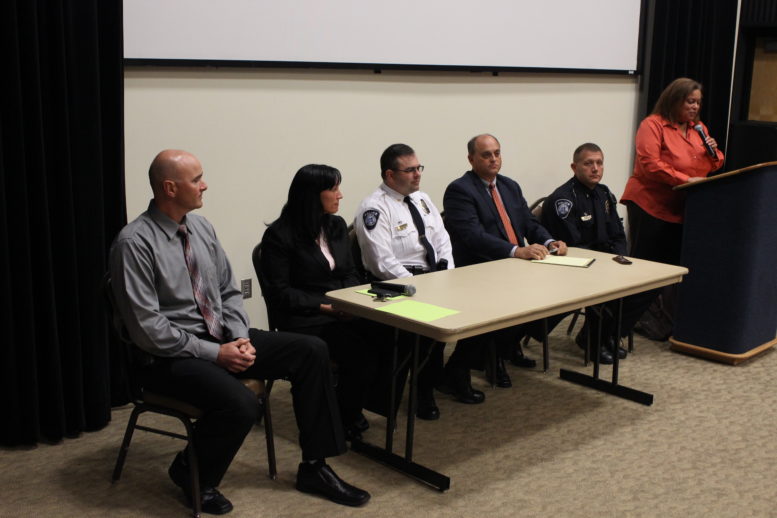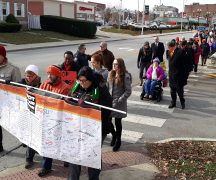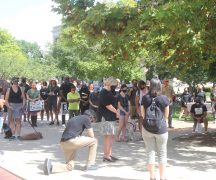By DAVID DUPONT
BG Independent News
The police in Bowling Green, either city or campus, don’t have to resort to using physical force very often. Bowling Green Police Chief Tony Hetrick said that in 90,000 interactions, officers on the BG force have used force 52 times, and BGSU Police Chief Monica Moll said her department’s experience was similar.
Rodney Fleming, the managing attorney at Student Legal Services, said that if citizens looked at the statistics, they’d see how little physical force is used.
Capt. Mike Campbell, who will be interim chief when Moll leaves BGSU at the end of the month, said that in looking at police conflicts that have been in the news, he sees faulty tactics in how the incidents were approached. More emphasis should be put on de-escalating a situation, and better communication, he said.
They were part of the “It’s Just Us: Real Talk with Real Cops,” held Friday at Bowling Green State University, and sponsored by Not In Our Town.
No matter how little force is used, all incidents are reported and looked at. “Even if it was a legal use of force,” Moll said, “maybe we could have used less.”
Hetrick said each instance is looked at by more than one supervisor, including himself. “Nothing is going to be swept under the rug.”
And, if citizens feel they have been unfairly treated, each department has a formal complaint process. If someone doesn’t trust the police to follow through, they can complain to other entities, Fleming said – city officials, his office, or Not In Our Town.
Hetrick said those complaints will be taken seriously. “As police chief I want to know that’s going on.”
The interactions between police and citizens are often tinged with distrust.
Moll talked about the importance of following officers’ instructions. Citizens may know they are not a threat but the officer doesn’t. “There’s a lot of anxiety on both sides,”
she said. “What I’m seeing is you have folks who have traditionally adversarial relationships with police and are going to be automatically nervous when police approach, and when police approach they may interpret that as something else that’s wrong.” Often tensions ease over the course of a stop, she said.
Ana Brown of resident life, who moderated the discussion, noted that “for a lot of us who are people of color, we don’t see that we necessarily get that time that white people do in a traffic stop.” Law enforcement is trying to address this with training on implicit bias.
Police are required, Hetrick said, to undergo such training, to help recognize attitudes that may interfere with performing their duties. The state started mandating this training two years ago.
The point, he said, “is to make sure we are in fact treating everyone fairly when we are out enforcing the law, that we are not letting these things affect how we do that.”
Everyone, Moll said, has their own set of expectations and biases. “We all see the world through our own lens. … The key is to recognize what they are and when they might be impacting their official duties because we want officers to be fair and impartial.”
Later in the session, the panel was asked about the perception by African Americans in Bowling Green that they are stopped for “driving while black.” Hetrick says this a persistent belief but the department’s statistics do not bear that out. An officer pulling a car over at night probably doesn’t know the race of the driver until the officer actually approaches the car.
Still both chiefs constantly monitor stats to make sure that isn’t a problem. “We’re trying to improve the data we collect,” Moll said.
Lt. Dan Mancuso, of the city police force, said that drivers coming from large urban areas may question the number of stops for faulty equipment. These often result in citations for more serious offenses such as drunk driving.
Having a diverse police force is important, Moll said. One way to recruit more women and people of color, she said, is to look at candidates who haven’t yet gone to the police academy. If they can pass the physical and psychological testing, then the department pays to send them to the academy.
Hetrick said the BG police are constantly looking to diversity, but admitted it’s had less success than he would like.
The panel was also asked about how the presence of BB and toy guns that look like real weapons complicates their jobs.
In Cleveland, such a confusion resulted in the death of Tamir Rice, who was shot by police, who did not know what he was carrying was a toy.
That was a tragedy for all involved, Moll said.
Hetrick said one of the two times he’s almost used his weapon involved student with an airsoft gun. Fortunately, he said, the student quickly complied with his order and dropped the gun, so the situation didn’t escalate.
Part of the marketing of these guns, he said, is how realistic they look. Earlier in the week, officers were called out for a weapon that was found in the bushes. It wasn’t until they picked it up did they realize it was a BB gun, not real weapon. It even had the projectiles that appeared to be bullets.
The panel was also asked about police officers who express racist, homophobic and sexist ideas on social media. They have the same Constitutional rights as other citizens, Moll said. However, if they identify themselves as police officers, and if they identify themselves as member of a particular department, that bar is higher.
She said as a chief she wants to know about such instances, so she can monitor to make sure the officer in question is not bringing those attitudes to his official duties.





